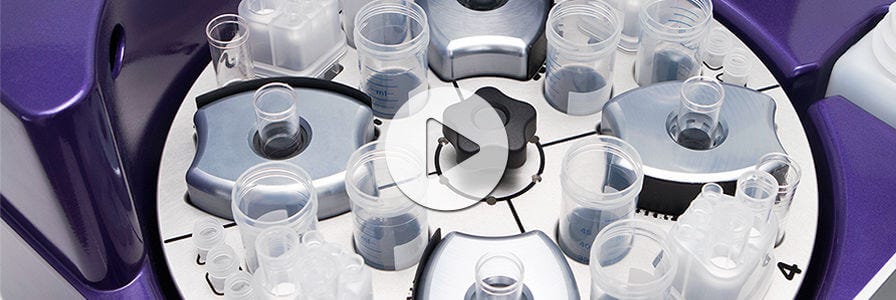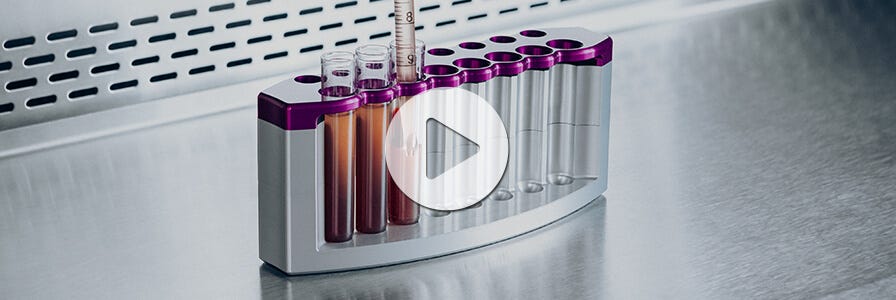Automated Lymphocyte Isolation for the Flow Cytometry Crossmatch Assay
- Document # 27172
- Version 1.1.0
- Jan 2022
Case Study
To improve the efficiency of cell preparation for the flow cytometric crossmatch (FCXM) assay, the University of Miami Immunomonitoring Laboratory has adopted an automated immunomagnetic cell separation system. This technical bulletin presents a case study of how this automated cell separation system frees up valuable technician time by minimizing sample handling and reducing the overall time to obtain cells for the FCXM assay, all without compromising assay sensitivity.
Background
The FCXM assay is part of a pre-transplant risk assessment to facilitate organ transplantation. The assay assesses whether the organ recipient has antibodies, also known as donor specific antibodies (DSAs), against the donor’s human leukocyte antigen (HLA). The assay involves mixing donor lymphocytes with recipient serum and detecting DSAs by flow cytometry. For analysis by flow cytometry, samples are stained with fluorochrome-conjugated antibodies that recognize T cells and B cells, and an anti-human IgG antibody to recognize DSAs.
Using high purity donor lymphocytes is critical to obtaining reliable FCXM assay results.1 However, traditional methods for isolating lymphocytes from donor blood and tissue—such as density gradient centrifugation (DCG)—can be time consuming, be difficult to automate, and result in inconsistent cell purities.2 This technical bulletin discusses how the University of Miami Immunomonitoring Laboratory has adopted an automated immunomagnetic cell preparation method that uses EasySep™ Direct reagents and the RoboSep™ instrument to make the lymphocyte isolation step more efficient.3
Methods
Lymphocytes were isolated from buffy coat by two different methods and their performance in the FCXM assay was compared. The first method—Manual DGC—employed cell isolation by DGC, using Ficoll-Paque® and Leucosep™ tubes, followed by a manual immunomagnetic granulocyte depletion step using Dynabeads® CD15. The second method—Automated RoboSep™ —involved fully automated immunomagnetic cell isolation with the RoboSep™ instrument (Catalog #21000) and the EasySep™ Direct Human Total Lymphocyte Isolation Kit (Catalog #19655). Cell preparations obtained using both methods were evaluated by flow cytometry for cell purity and viability. Platelet contamination was determined by complete blood count using a Sysmex® XN-3000™. FCXM assays were performed according to the laboratory's pronase-free protocol, using the cell preparations and negative and positive control sera samples.
Results & Discussion
The University of Miami Immunomonitoring Laboratory group showed that, compared to the Manual DGC method, the Automated RoboSep™ method resulted in cell preparations with higher lymphocyte purity (Figure 1), without the need to perform additional red blood cell lysis and granulocyte depletion steps. The Automated RoboSep™ method thereby reduced the average cost of reagents required per sample, leading to significant cost savings for the laboratory.
Compared to the Manual DGC method, using cells isolated by the Automated RoboSep™ method had no impact on FCXM assay sensitivity (Figure 2 and 3). All Mean Fluorescence Intensity (MFI) values were within the expected ranges for positive and negative controls. There was a trend of higher MFI values when using cell preparations obtained with the Automated RoboSep™ method (Figure 2). The group at the University of Miami Immunomonitoring Laboratory attributes this trend to cell preparations with higher lymphocyte purity, although more in-depth studies are needed to confirm this.
In addition to providing samples with higher lymphocyte purity, the Automated RoboSep™ method took less time: ~1 hour for Automated RoboSep™ compared to ~2.5 hours for the Manual DCG (Table 1). Most importantly, the Automated RoboSep™ method reduced the active time spent handling samples and performing cell isolation to ~0.5 hours from ~2 hours, thus reducing the hands-on time by more than 70%. This means that using the Automated RoboSep™ method can save a technician's valuable time and contribute to increased laboratory sample throughput and productivity.
…automation using EasySep™ [Direct] Kit on RoboSep™ markedly improves the purity of the cells with identical results and sensitivity in the FCXM. The use of [EasySep™ Direct Kit on RoboSep™] proved to be more efficient and cost effective, reducing not only the reagent cost but also more importantly “hands-on” tech time.

Figure 1. Automated Cell Isolation Using RoboSep™ Increases Lymphocyte Purity
Cells were isolated using either density gradient centrifugation followed by granulocyte depletion (Manual DGC) or the EasySep™ Direct Human Total Lymphocyte Isolation Kit (Catalog #19655) automated on the RoboSep™ instrument (Automated RoboSep™) and analyzed for (A) CD45+ cell purity, (B) contaminating platelets, (C) contaminating non-lymphocytes, and (D) cell viability. (A-C) The Automated RoboSep™ method resulted in cell preparations with significantly higher lymphocyte purity and reduced platelet and non-lymphocyte contamination compared to the Manual DGC method. (D) Cell viability was comparable for both methods. Each column with error bars represents the mean ± SD (n = 20 donor samples). Data kindly provided by the University of Miami Immunomonitoring Laboratory.

Figure 2. Automated Cell Isolation Using RoboSep™ Does Not Compromise the Sensitivity of the FCXM Assay
Cells were isolated from 20 donor samples using either density gradient centrifugation followed by granulocyte depletion (Manual DGC) or the EasySep™ Direct Human Total Lymphocyte Isolation Kit (Catalog #19655) automated on the RoboSep™ instrument (Automated RoboSep™). Cell preparations were used to perform (A) T cell FCXM and (B) B cell FCXM assays with negative and positive control sera. Mean fluorescence intensity (MFI) was measured by flow cytometry. The MFI values obtained using the two different cell isolation methods were within the accepted MFI ranges for positive and negative controls. Each column with error bar represents the mean ± SD and each grey or orange symbol represents an individual donor sample (n = 20 donors). Data kindly provided by the University of Miami Immunomonitoring Laboratory.

Figure 3. Automated Isolation of Lymphocytes Using RoboSep™ Does Not Compromise DSA Detection
Cells were isolated from one donor sample using either density gradient centrifugation followed by granulocyte depletion (Manual DGC) or the EasySep™ Direct Human Total Lymphocyte Isolation Kit (Catalog #19655) automated on the RoboSep™ instrument (Automated RoboSep™). Cell preparations were used to perform (A) T and (B) B cell FCXM assays against negative control sera or several dilutions of positive control sera. The Mean Fluorescence Intensity (MFI) Ratio was calculated by using the negative control sera sample as baseline. The negative cutoff ratios for the T and B cell FCXM assays were defined as 2.0 or 4.4, respectively. Data kindly provided by the University of Miami Immunomonitoring Laboratory.
Table 1. Automated Isolation of Lymphocytes Using RoboSep™ Reduced the Cell Separation Process to 1 Hour and the Hands-On Time to 30 Minutes
(duration in minutes)
(duration in minutes)
Summary
The authors concluded that using the Automated RoboSep™ method, i.e. EasySep™ Direct Human Total Lymphocyte Isolation Kit on the RoboSep™ instrument, resulted in the following:
- No change in FCXM results compared to their Manual DGC method.
- Increased lymphocyte purity without the need for additional red blood cell lysis and granulocyte depletion steps.
- More than 50% reduction in the overall time to obtain cells: from ~ 2.5 hours to ~1 hour.
- Minimized sample handling, thereby reducing total technician hands-on time by more than 70%: from ~2 hours to ~0.5 hours.
- Significant cost savings and overall increased sample processing efficiency.
Automated Lymphocyte Isolation for the Flow Cytometric Crossmatch Assay
RoboSep™ instruments work with EasySep™ Direct to isolate untouched and highly purified cells directly from whole blood without density gradient centrifugation, sedimentation or red blood cell (RBC) lysis. Highly purified cells are immediately ready for the FCXM assay. Cell isolation with RoboSep™ and EasySep™ Direct is gentle, fast, and efficient and works well on older blood samples.
Why Use RoboSep™?
Streamline and standardize your cell isolations to minimize hands-on time and increase laboratory throughput with the fully automated RoboSep™ instruments. Isolated cells are immediately ready for downstream HLA testing including FCXM, CDC crossmatch, chimerism analysis and more.
How Does EasySep™ Direct Work?
EasySep™ Direct is a powerful immunomagnetic technology that isolates highly purified cells without centrifugation and RBC lysis. Cell isolations can be performed manually or can be automated using RoboSep™-S instruments.
Product Listing
Select EasySep™ Direct Products
RoboSep™ Instruments
Recommended Antibodies for Flow Cytometric Crossmatch Analysis
References
- Liwski R et al. (2016) P099 The impact of lymphocyte purity on flow cytometry crossmatch (FCXM) assay. It’s not purely theoretical. Hum Immunol 77, Suppl: 110–111.
- Liwski RS et al. (2018) Rapid optimized flow cytometric crossmatch (FCXM) assays: The Halifax and Halifaster protocols. Hum Immunol 79(1): 28–38.
- Fernandez-Bango C et al. (2017) P230 Automation for flow cytometry crossmatch (FCXM) lymphocyte isolation using robosep. Hum Immunol 78: 224.
Request Pricing
Thank you for your interest in this product. Please provide us with your contact information and your local representative will contact you with a customized quote. Where appropriate, they can also assist you with a(n):
Estimated delivery time for your area
Product sample or exclusive offer
In-lab demonstration




